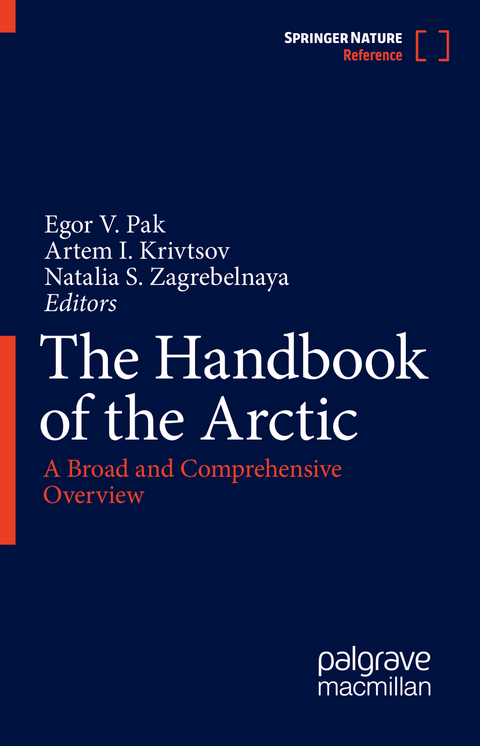
The Handbook of the Arctic
Palgrave Macmillan (Verlag)
978-981-16-9249-9 (ISBN)
This book offers a broad and holistic overview of issues in the Arctic today, a region which is transforming due to changing world order and climate agenda. While new economic opportunities - and with China, as well as other geopolitical players in the region - are emerging, new security challenges are arising as well. In this comprehensive scholarly resource, contributors from around the world and from a broad variety of disciplines share their thoughts on the future of the Arctic, in a manuscript that will be of interest to researchers, economists, and policymakers.
Egor V. Pak is an Associate Professor in the Department of International Economic Relations and Foreign Economic Affairs as well as in the Department of International Transport and Logistics, MGIMO University. He received his Ph.D. in Economics from MGIMO University. His research expertise lies in the areas of international transport and logistics, international transport policy, transport and logistics in the Eurasian Economic Union, and regional connectivity Artem I. Krivtsov is Doctor of Economics, Professor in the Department of Management, Marketing and Foreign Economic Activity, MGIMO University. His main research interests include financial management, economic analysis, and financial reporting analysis. Natalia S. Zagrebelnaya is an Associate Professor in the Department of Management, Marketing and Foreign Economic Activities, MGIMO University. She received her Ph.D. in Economics from MGIMO University. Her main research interests include management, marketing, merchandizing, organizational behavior, international marketing, and environmental marketing.
Introduction.- chapter 1. Conceptualizing the Arctic.- Chapter 2. International Cooperation in the Arctic: The Arctic Council.- Chapter 3. A European Arctic Policy: Interests of Non-Arctic States and the EU.- Chapter 4. Interests of Non-Arctic Asian States in the Region.- Chapter 5. Revisiting the Arctic Strategy of Russia till 2035.- Chapter 6. Geoeconomic Aspects of Arctic Exploration.- Chapter 7. Arctic Economy: Trends and Prospects.- Chapter 8. Economy of the Russian Arctic Zone.- Chapter 9. Financial Resources for the Arctic Exploration.- Chapter 10. FDI specifics in Greenland, Northern Canada and Alaska.- Chapter 11. Including Arctic in Multilateral Trading System Agenda.- Chapter 12. Innovative Aspects of Fishery Cooperation of the Arctic States.- Chapter 13. Ideals and Realities of the Northern Sea Route: Opportunities for Russia.- Chapter 14. Technical Aspects of Shipping via the Northern Sea Route.- Chapter 15. Shipping via the Northern Sea Route: Case of Oil andGas Transportation.- Chapter 16. Prospects of Shipbuilding for the Needs of the Arctic Region.- Chapter 17. Insuring Shipments in the Arctic Zone.- Chapter 18. Raising the Landline Rail Connectivity of Russia in the Arctic Zone under the Belt and Road Initiative.- Chapter 19. Digitalization of the Artic.- Chapter 20. Digital Technologies of Oil and Gas Companies in the Development of the Arctic Shelf.- Chapter 21. . Environmental Aspects of the Arctic Development.- Chapter 22. Sustainable Development and Corporate Social Responsibility in the Arctic Zone.- Chapter 23. Sustainable Development in the Arctic: Case of Alaska.- Chapter 24. Revisiting the Sustainable Development of the Arctic Zone of Russia.- Chapter 25. Participation of Foreign Companies in the Sustainable Development of the Arctic Regions: Comparison of Svalbard and Yamalo-Nenets Autonomous Okrug.- Chapter 26. Energy Development of the Russian Arctic and Sustainable Development: A Comparative Analysis of the Activities ofEnergy Companies in the Region.- Chapter 27. Energy Security in the Arctic Zone.- Chapter 28. The Evolving Security Landscape in the Arctic.- Chapter 29. Human Security in the Arctic.- Chapter 30. High North Communities Demographic Development in Eight Arctic States.- Chapter 31. Residents of the Arctic Zone: Economic and Legal Aspects.- Chapter 32. Research Policy and Cultural Specifics in the Arctic Region: Case of Canada.- Conclusion.
| Erscheinungsdatum | 14.03.2023 |
|---|---|
| Reihe/Serie | The Handbook of the Arctic |
| Zusatzinfo | 104 Illustrations, color; 13 Illustrations, black and white; XLV, 1223 p. 117 illus., 104 illus. in color. In 2 volumes, not available separately. |
| Sprache | englisch |
| Maße | 155 x 235 mm |
| Themenwelt | Naturwissenschaften ► Biologie ► Ökologie / Naturschutz |
| Naturwissenschaften ► Geowissenschaften ► Geografie / Kartografie | |
| Sozialwissenschaften ► Politik / Verwaltung ► Europäische / Internationale Politik | |
| ISBN-10 | 981-16-9249-1 / 9811692491 |
| ISBN-13 | 978-981-16-9249-9 / 9789811692499 |
| Zustand | Neuware |
| Haben Sie eine Frage zum Produkt? |
aus dem Bereich


